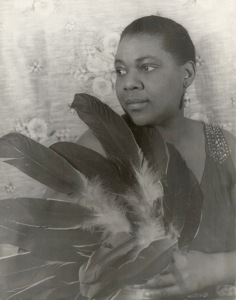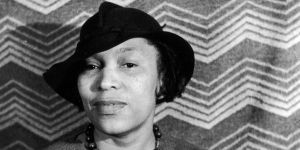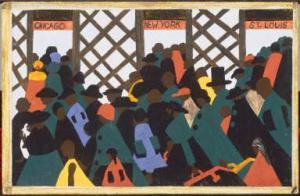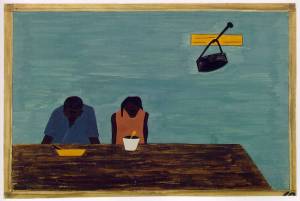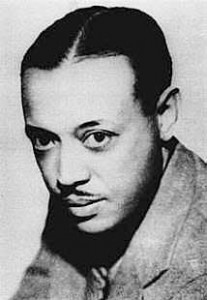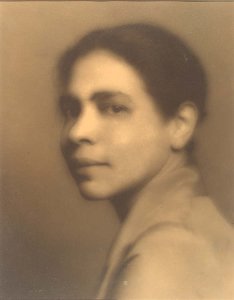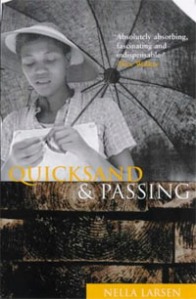 Langston Hughes was one of the most prominent figures of the Harlem Renaissance. Remembered primarily as a pioneer of jazz poetry, Hughes also wrote several plays, novels, short stories and essays. In 1926 Hughes wrote ‘The Negro Artist and the Racial Mountain’, an essay which offered a strong critique of the upper and middle class blacks and their contribution to Harlem Renaissance art whilst praising that of the lower working class blacks. Hughes sees a fundamental difference between these distinct class groups; the ‘low folk’ embrace their heritage whereas the ‘“high-class” Negro’ rejects it in favour of white standards of aesthetic.
Langston Hughes was one of the most prominent figures of the Harlem Renaissance. Remembered primarily as a pioneer of jazz poetry, Hughes also wrote several plays, novels, short stories and essays. In 1926 Hughes wrote ‘The Negro Artist and the Racial Mountain’, an essay which offered a strong critique of the upper and middle class blacks and their contribution to Harlem Renaissance art whilst praising that of the lower working class blacks. Hughes sees a fundamental difference between these distinct class groups; the ‘low folk’ embrace their heritage whereas the ‘“high-class” Negro’ rejects it in favour of white standards of aesthetic.
The central argument of his essay is coloured by class-based antagonisms. Upper and middle class blacks have distanced themselves from their African heritage because of their upbringing and thus have an appreciation of white culture over black culture. Hughes recounts two anecdotes to demonstrate this. The first, a conversation with a young, middleclass, African-American poet who told Hughes ”I want to be a poet–not a Negro poet.”2, which Hughes analyses as a desire to be white. In the other incident, Hughes talks of ‘a prominent Negro clubwoman in Philadelphia’ who paid to see a white musician but would not do the same to see a black woman sing which demonstrates class based elitism with racial implications. From these isolated experiences, Hughes makes critical inferences about middle and upper class black Americans and how they view their own race. Laurie F. Leach, a biographer of Hughes, analyses Hughes critique of black elites as such; ‘Hughes argued that the black middle class is the source of this desire to be white and accepted by whites. In middle-class homes, the children are taught to hold themselves superior to those of their race with less education, money and social status.’ In Leach’s view, Hughes saw race and class as inextricable from one another; the way in which one saw themselves in economic terms defined the extent to which they chose to assimilate themselves into white society.
Hughes’s idea of the ‘racial mountain’ essentially entails that black Americans have been socialized to hold up white culture as superior to their own. In doing so they have constructed obstacles to creating authentic representations of black cultural heritage; …this is the mountain standing in the way of any true Negro art in America–this urge within the race toward whiteness’ . This remains an issue in contemporary discussions on the relationship between race and culture. High profile black artists, notably Michael Jackson, Jennifer Lopez and Whitney Houston, have been accused of ‘whitening up’. In his article ‘Whitney Houston Critics called her “too white”’ Larry Elder notes; “Houston struggled with drug and alcohol problems for years …” But Houston also struggled with something else…ridicule and ostracism for “selling out,” or “acting white,” or not being “black enough.” This shows that the idea of racialized culture is still relevant today. Hughes criticised his Harlem Renaissance peers for writing in a way that pandered to white aesthetic values. Over half a century later, musicians were being judged according to race-based expectations.
Hughes was one of the younger generation of renaissance figures who looked disparagingly at the ‘The Nordicized Negro Intelligentsia’ . Claude McKay was another prominent Harlem writer who saw the working class as possessing a greater, more authentic black culture notably in his seminal novel Home to Harlem (1928), which focuses on the grimier, working class side of Harlem. Furthermore, in his autobiography ‘A Long Way from Home’ McKay emphasises the detrimental effect that black elites have on the Harlem Renaissance movement as a whole; ‘…among the Negro artists there was much of that Uncle Tom attitude which works like Satan against the idea of a coherent and purposeful Negro group. Each one wanted to be the first Negro, the one Negro and the only Negro for the whites instead of for the group.’
Hughes’s description of working class blacks’, stands in stark contrast to his scorn for black elitism. Leach notes; ‘Hughes celebrates the “low-down folks” … These people do not waste time imitating whites or feeling ashamed of themselves.’ Hughes’s admiration comes across clearly; he praises their unashamed pride in their African heritage, and sees them as the ones to produce art which truly reflects the black culture and experience; ‘perhaps these common people will give to the world its truly great Negro artist, the one who is not afraid to be himself.’ His antipathy towards the intelligentsia who strive to assimilate into white society, combined with his enthusiasm for the potential of “low-down folk” to produce authentic representations of black art leads Hughes to assign a socio-cultural responsibility to working class black artists to break down the ingrained perceptions that black culture is of lesser value;
‘…it is the duty of the younger Negro artist, if he accepts any duties at all from outsiders, to change through the force of his art that old whispering “I want to be white,” hidden in the aspirations of his people, to “Why should I want to be white? I am a Negro–and beautiful”?
For all its virtues and significance, Hughes’s essay does have a level of hypocrisy which cannot be ignored. He devotes much of the article to praising the new generation of black artists for their individuality and embracing their heritage; ‘We younger Negro artists who create now intend to express our individual dark-skinned selves without fear or shame.’12 And yet, he also states ‘An artist must be free to choose what he does, certainly, but he must also never be afraid to do what he must choose.’ This implies that Hughes sees the expression of African-American heritage as the only option for emerging black artists, which conflicts somewhat with his emphasis on individual expression.
 In spite of this contradiction, ‘The Negro Artist and the Racial Mountain’ serves as one of the most important essays of the Harlem Renaissance era, and as an unofficial manifesto for the younger generation, of Harlem Renaissance figures. It serves as an effective portrayal of the complexities and conflicts between the different artistic circles of the movement. In addition, the essays represents a turning point for Hughes. Dolan Hubbard emphasises the significance of this essay in terms of Hughes’s within Harlem; ‘It was the publication of The Negro Artist…that signalled Hughes’s transformation from a promising writer of nonfictional prose to one of America’s most engaging essayists.’ This essay marks Hughes out as one of the exceptional figures of the movement and demonstrates the endurance of his ideas is evident from their appearance in contemporary debates on race issues.
In spite of this contradiction, ‘The Negro Artist and the Racial Mountain’ serves as one of the most important essays of the Harlem Renaissance era, and as an unofficial manifesto for the younger generation, of Harlem Renaissance figures. It serves as an effective portrayal of the complexities and conflicts between the different artistic circles of the movement. In addition, the essays represents a turning point for Hughes. Dolan Hubbard emphasises the significance of this essay in terms of Hughes’s within Harlem; ‘It was the publication of The Negro Artist…that signalled Hughes’s transformation from a promising writer of nonfictional prose to one of America’s most engaging essayists.’ This essay marks Hughes out as one of the exceptional figures of the movement and demonstrates the endurance of his ideas is evident from their appearance in contemporary debates on race issues.
Bibliography
Elder, Larry, ‘Whitney Houston’s Critics Called her “too white” — Black Republicans Can Relate’
(LarryElder.com, 2012) ‘The Portable Harlem Renaissance Reader’ (London: Penguin Books, 1995)
Hubbard Dolan and Hughes, Langston, ‘The Collected Works of Langston Hughes: Essays on art, race, politics, and world affairs’ (Columbia, Missouri: University of Missouri Press, 2002)
Hughes, Langston, ‘The Negro Artist and the Racial Mountain’ in ‘The Nation’ (June 23 1926)
Leach, Laurie F. ‘Langston Hughes: A Biography’ (Westport Connecticut: Greenwood Publishing, 2004)
McKay, Claude, ‘A Long Way From Home: The Harlem Intelligentsia’ in Levering Lewis, David ed.,
